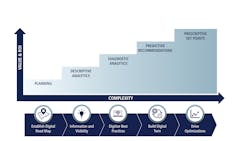Training is key to digital wastewater success for small utilities
As with larger wastewater utilities that have likely started adopting smart water management, the thousands of smaller rural and suburban collection systems are contemplating how to make their own digital water journeys to increase resilience and improve operational efficiencies.
A number of challenges face these operators who want to get started with digital. Along with the increasing challenge of training their workforce and attracting talented technicians, the question is: how much and how fast can these digital techniques be adopted successfully, and what is it going to cost?
Add the effects of climate change with more frequent and more intense precipitation events, cyber-attacks and energy resiliency, and the result is a challenging situation for wastewater utility operators and managers. They must do more with less, manage risk by anticipating and addressing future challenges while replacing an aged infrastructure, many times with doubtful or inadequate funding.
The AWWA State of the Water Industry 2022 Executive Summary identified major challenges faced by water utilities. The new digital water industry has introduced a wide variety of sensor, software and hardware tools with the capabilities to help address 15 of the summary’s 20 challenges.
Today’s digital innovation will be tomorrow’s normalcy, but a pivot is required. To make digital water management happen, operators must untangle the complicated array of technologies and find out where to start and what to prioritize, assess both capital and operational costs, and calculate associated savings over the current operation.
Defining digital wastewater transformation
Smaller utilities are looking to digital transformation to improve their operations. So, what is digital transformation? In a nutshell, it is the process of translating data into information for improved decision making. The transformation starts by assessing what systems a utility already employs, the challenges and needs a digital tool is intended to address, and the gap between the current and intended states.
Digital tools to address the gap are then researched and a digital roadmap is defined to close the performance gap and achieve the intended goals by becoming a more digitally informed utility. Each utility’s transformation is unique. That means the answer to the burning questions — how do I start and what is it going to cost — depend on the utility’s situation.
Wastewater utilities typically have some form of the following systems in place, in either a digital or analog form:
- System maps or geographic information system (GIS);
- Customer information system (CIS);
- Supervisory, control and data acquisition (SCADA);
- Maintenance or work orders management system, whether basic or computerized (CMMS);
- Laboratory information management system (LIMS);
- Operational optimization tools, such as excel spreadsheets;
- Enterprise asset management system (EAMS);
- Flow metering, infiltration and inflow study and pipeline inspection data; and
- Other instrumentation, sensors, software, or analog operational tools.
The systems listed above commonly do not interact with each other, with data from each system remaining within its own data silo. Data-informed decision-making thus requires significant efforts to access, download, translate and analyze these data into meaningful formats, meaning that a time-constrained manager often makes decisions with an incomplete picture. The new digital utility upgrades these systems to a digital format and then combines information gathered from these various data sources and operational silos into a real-time integrated data model called a digital dashboard.
The data from all systems is gathered into a centralized digital data historian, and the data is translated and curated into meaningful information that operators can use for better-informed decision making. The digital dashboard is then translated into appropriate formats to enable greater mobility for operations teams via access on smartphones, tablets and laptops for technicians on the field, at home or in the office.
Digital twins & dashboards
Moving beyond dashboards, digital twins of water systems can be developed to compare scenarios, model changes and conduct training in an offline format that is nearly identical to the physical system. Data science methods such as machine learning can then be applied to the digital twin of a system. These can provide early awareness of risks and offer optimized setpoint recommendations, saving electricity, chemicals and other benefits.
For example, consider a theoretical small community in the western United States, with 7,000 wastewater connections. The utility has begun its digital journey by implementing a GIS system, so that operators know where the pump stations, utility maintenance holes and other system assets are located, along with an inventory of their parameters. It has a separate paper-based work-order system, and local pump station controls are in place with alarm dialers.
The initial goal is to implement a computerized maintenance management system (CMMS) that is integrated with the GIS system so that work orders and asset conditions can be tracked and verified over time to better inform capital investment decisions.
From here, the wastewater utility leader can prioritize a new centralized SCADA system to bring awareness and remote control of critical pump stations into a central headquarters location. In times of crisis, this will increase the resilience of the utility.
From a resources standpoint, this can reduce operator trips to the pump stations to monitor conditions, freeing up the team for other needs and reducing fuel costs and emissions associated with truck rolls. The utility may even choose to take it a step further by implementing a workforce mobility system to provide visibility of the system across mobile devices, modernizing the alarming from the current dial, drive, look and react approach.
The next step for this small town is to deploy real-time sensors in key locations in the collection system to enable conditions-based maintenance. Many wastewater utilities conduct jet-cleaning and root-sawing activities on their gravity interceptors based off of past overflow events, perceptions of importance or risk, and any recent robotic camera inspections that may be available. In most cases, maintenance activities are more frequent than necessary and driven by historical reasoning, such as “that’s how we’ve always done it,” or “it overflowed once eight years ago.”
Some areas may even get special political attention, for example the sewer lines serving city council members’ houses or similar. Readily available and simple to deploy sensor systems can be installed to provide real-time conditions into a centralized location, allowing public works leaders to confidently switch to conditions-based maintenance. In doing so, they can free up their understaffed maintenance teams to address the backlog now captured in the new CMMS system.
The data collected from the pump station SCADA system and the collection system sensors will be catalogued into a digital historian with appropriate tagging to ensure the usefulness of the data as the town continues its digital journey. The town can now use this data to compare or better correlate a hydraulic model of its collection system.
A digital platform solution can be implemented to create a digital twin of the system, allowing offline simulations to train new team members or test bypassing scenarios for planned construction projects. With a digital twin in place, data science methods such as machine learning can be applied to optimize pumping for energy savings, or maximize system attenuation and storage to avoid overflows during precipitation events.
The utility leader for the small town can now shift from historic or reactionary operations to a more confident, scientific approach. The utility can add features and new systems. One such example includes adding sensors to the digital platform when it makes operational sense and as budget allows.
While cost is always a challenge, today’s software platforms come in the form of software-as-a-service, where data is stored in the cloud. There are no IT infrastructure costs for servers or other on-premises items, which are now provided in a centralized fashion. Software updates and security upgrades are continuously updated by the provider along with timely, integrated help desk support.
The wastewater community already knows the strengths and weaknesses of its infrastructure. With tools such as real-time conditions sensors, a digital twin and data science tools, priorities can be managed so that maintenance activities are directed and money is spent where it is needed as defined by data, rather than by instinct or uninformed intervals.
Digital water roadmap
The first step in a digital journey is the most important. Each utility’s case is unique, and the utility manager must first answer the question: What does your unique digital transformation look like? This is where a digital roadmap comes into play.
Step 1 of the digital roadmap sets the stage for steps 2 through 5. As a utility takes these steps, the journey increases in complexity, but it also increases value and return on investment.
The roadmap writing process starts with a thorough site assessment typically led by a consulting owner’s engineer. After obtaining system descriptions, understanding existing data sources and determining historic data availability, the engineer then interviews key personnel in operations, engineering, leadership and finance, researches the regulatory context, and performs an on-site visit. All this goes into the existing conditions engineering report.
Engineers then perform a multi-dimension gap analysis — basically what a utility has, what it does not have and what it will take to achieve project and digital goals —and then research technology providers and products with the capabilities to close the identified gaps. A cost-benefit analysis is then completed, leading to an initial draft of the four-step journey to the project goals. Feedback is then incorporated, any further needed scenarios are evaluated and the roadmap is finalized. Depending on the utility size and complexity, the roadmap process can typically be completed within four months.
With a roadmap in place, a utility can analyze its entire operation and know what it will require to implement impactful digital tools. The roadmap is used to make cases for capital investment and obtain the budgets that will provide long-term value. The digital roadmap can be integrated with the traditional wastewater master plan to ensure digital upgrades are done in a logical and value-added manner to complement the physical infrastructure upgrades.
That answers the question about how to get started, but it leaves the second question unanswered: how much it will cost? The answer to that depends on the current state of a utility and where it wants to be with digital systems in the near- and long-term.
The good news is that operators can start their digital journeys with an a la carte approach. There is a wide range of costs depending on the extent and sophistication of the digital systems that are implemented. Owners and staff should remember that the idea around operating with an understanding of facts instead of guesswork pays for itself through more efficient operations and mitigated risks.
A sound digital roadmap will clearly show the costs and benefits of the journey to becoming a digital utility.
About the Author
Steve Green
Steve Green is the digital water practice leader at Stanley Consultants. Steve has spent his 23-year career in business development and project delivery roles in the water industry, helping water system owners improve their infrastructure via technology adoption and collaborative project delivery. Steve holds a bachelor’s degree in bio-resources engineering from Montana State University and an MBA from the University of Washington. He can be contacted via email at [email protected].

